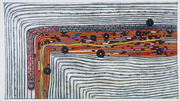Luis Cruz Azaceta
Contemporary Arts Center
by Natalie Sciortino, ARTFORUM
What does it mean to isolate one year of an artist’s production? For this exhibition, Dan Cameron has organized a unique retrospective of the prolific local artist Luis Cruz Azaceta. The year selected, 1999, was laden with ethnic and territorial disputes—atrocities in Kosovo, East Timor, Russia, Kashmir, and eastern Congo riddled the globe. Closer to home, five-year-old Elián González survived a harrowing exodus from Cuba to Florida and in the process became a polarizing icon of domestic and human rights. This time emerges as a psychological juncture; Y2K distress was mixed with periods of reflection and anticipation.

Bloodline, 1999
The global zeitgeist reveals itself in varying degrees throughout this body of Azaceta’s work. Confinement, imprisonment, liberation, movement, safety, refuge, spaces, and notions of humanity all come into play. Bold, chunky lines of dark paint, layered with pasty, creamy shades of off-white, grays, and other neutrals, run across nearly every painting. Azaceta often incorporates intestinal, twisty, truncated figures that nod to Francis Bacon and Philip Guston while breaking this dense linear flow. In Drifting, a severed male figure attaches limply to an inner tube adrift in a sea of lines. At times, the lines remain as patterns, while in works like Ethnic Cleansing, they transform into tissue, cells, blood vessels, and other biomorphic entities. The lines in Azaceta’s compositions often appear tubular through the use of undulating color; a certain duality of existence is revealed by such optical illusions. For example, in Pitfall and Blocked, ascent and descent, entrance and exit, blend together.
For the artist, the late 1990s marked the beginning of wonderfully visceral “chromogenic” collage pieces, in which the mesmerizing lines persist through more literal forms of industrial scenery. The same blocky architectural elements found within the paintings work here to interject, block, and break the overall flow of spaces. The works reflect not only on one year of Azaceta’s lifetime but on one of ours as well.
